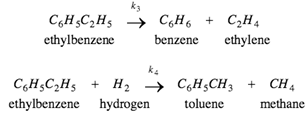Reference no: EM13831244
Background:
Styrene is a critical commodity chemical used by many chemical processes and industries, mainly polymer industries (Polystyrene).
Your assignment, with more details given below, is to perform a complete Level Conceptual Design and analysis for a commercial-scale process to produce styrene from ethylbenzene. The Process Basis is given below, although there is one decision that must be made before it is completed.Level 0: Process Basis
Reaction Pathway: Styrene is produced through vapor-phase endothermic catalytic decomposition of ethylbenzene. The reaction occurs at temperatures from 550 - 750 °C and pressures ranging from 25 to 75 psia. To supply energy for the endothermic reaction High pressure (high temperature) steam is produced in a furnace and added to 29 psia, 140 °C ethylbenzene feed; the reactor itself is run adiabatically.
Styrene is produced through the following reversible reaction:

Undesirable complete reactions of ethylbenzene also take place:

We do not have a simple relationship between selectivity and conversion; rather, we have detailed reaction kinetics given below (Consider: could you use the kinetics to FIND S as a function of X?):
r1 = 1.177 x 108 exp(-21708/RT)Peb
r2 = 20.965 exp(7804/RT)PstyPH2
r3 = 7.206 x 1011 exp(-49675/RT)Peb
r4 = 1.724 x 106 exp(-21857/RT)PebPH2
where pi are in bar; T is in K, R is 1.987 cal/mol-K and ri are in mol/m3-s.
Note that the styrene reaction can be equilibrium limited (Consider - you may wish to find an expression for the equilibrium constant)
Product Specifications:
16,000 lb/hr styrene 99.5% purity (by weight)
The plant is designed to operate 8200 hr/yr
Raw Material Specifications:
95.2 mol% Ethylbenzene (2% benzene, 1.2% toluene, 1.6% CH4) @ 29 psia, 140 °C)
Steam is available at about 610 psia, about 800 °C (eventually your plant will include steam production)
Task 1 - Level 0 specifications
Construct a table that summarizes the Level 0 information that you have, and information that you might need to obtain. Comment on choices that might need to be reconsidered and why. Comment on what you will do about currently missing information.
Task 2 - Economic Potential Level 1
Find price data for ethylbenzene and styrene. Find the level 1 economic potential for this process at any date in the past 10 years. If possible, find data over time, and plot the EP1 as a function of time. Comment on any trends.
Task 3 - Level 2 Specifications
We have made the Level 1 decision of choosing a continuous process.
Construct a table that summarizes the Level 2 decisions (including sub-decisions) that you must make.
Describe each Level 2 Option (a Level 2 Option comprises a set of Level 2 decisions) that you feel should be examined, in the order you think they should be examined: for each Option, give the list of Level 2 decisions comprising that Option, and an explanation of the rationale for the decisions comprising that Option in logical sequential order. Try to make as much use of the heuristics given by Douglas and the Class PowerPoint; when citing a heuristic or reason, give its source (use formal citations). Also for each Option, list the information that you might need to complete the evaluation and Analysis of EP2. Comment on what you can do about currently missing information.
Task 4 - Level 2 Design
Complete a Level 2 Conceptual Design of the Styrene Process. Document your efforts by first presenting the Level 2 flowsheet that accurately represents the decisions comprising your primary Option as given above. Do a degrees of freedom analysis on your Level 2 flowsheet, then choose and explicitly specify and justify your design variables.
Task 5 - Material Balancing
Construct a Stream Table for your Flowsheet as a function of your chosen Design Variable(s). Be sure to clearly document the development of the entries in the table.
Choose one set of quantitative values for your Design Variable(s) and include a table of numerical values as an example calculation in units of lbmol/hr.
Task 6 - Level 2 Economic Potential
Determine the Economic Potential - Level 2 (EP2) for your Design. Construct an appropriate graphical summary of EP2vs. (and potentially as a function of) your Design Variable(s). Discuss the outcome in terms of next steps and any insight gained.